

To go from one continent to another with your vehicle, you need to have it transported on a ship. Shipping is one of the largest expense items on a long, motorised trip. In this article, we’ll give you all the information you need to transport your vehicle across oceans.
Between 26th and 28th August 2020, we carried out a large survey among 398 people who’ve done a long, motorised trip. We asked them many questions about their vehicle and their way of travelling. We’ll refer to this throughout this article.
This question mainly comes up if you’re thinking about travelling overland in America.
According to our survey, amongst European people who travelled overland in America:
Travellers who opted for shipping to America had much more costly vehicles ($25,000 / €25,000 / £22,000 on average) than those who bought their vehicle out there ($5,000 / €5,000 / £4,400 on average).
Almost all British overlanders in Asia travel with a vehicle that they bought in their home country.
This is also the case for overlanders in Africa. More often than not, they make their way to Europe and then cross the Mediterranean by ferry between Spain and Morocco. Some of them have their vehicles transported between the UK and South Africa.
Most overlanders in Australia or New Zealand buy their vehicle out there, because shipping to these countries is extremely expensive and the quarantine inspection is rigorous.
The shipping routes most used by overlanders are those connecting Europe to America as well as the crossing between Panama and Colombia (it’s impossible to go from North American to South America by road). These routes make up two-thirds of the crossings mentioned by our survey respondents.
In the UK, most travellers embark or disembark their vehicle in Tilbury, Liverpool or Southampton, three ports that provide both ro-ro and container services.
In Europe, almost all travellers embark or disembark their vehicles in Antwerp (Belgium). The ports of Zeebrugge (Belgium), Hamburg (Germany), Le Havre and Saint-Nazaire (France) are less used.
In North America, the most used port is Halifax (Canada). Some travellers choose to go through Baltimore (United States) or Veracruz (Mexico).
In South America, the busiest port is Montevideo (Uruguay). Some travellers choose to go through Zárate, the port near Buenos Aires (Argentina) or Cartagena (Colombia). Brazilian ports are known to be very complicated for administrative purposes.
In Asia, the most popular maritime routes are:


The first step in organising your shippings is figuring out how your vehicle is going to travel. The mode of transport you choose will mainly depend on the size of your vehicle. If size allows, pick a container to avoid the risk of theft and damage.
Lots of travellers buy a specific-sized vehicle so that it fits exactly into a container. If you can’t fit it into the container but you’re only a few centimetres out, you can deflate the tyres a little bit.
As its name suggests, in a ro-ro, vehicles board from an access ramp and are simply parked on the deck of a ship. Ferries which cross rivers or short distances at sea are often equipped with ramps, but the term ro-ro is usually reserved for large roll-on / roll-off ships that cross oceans.
All passenger vehicles, regardless of their size, can be transported by ro-ro. Unlike ferries, ro-ros don’t normally accept passengers on board.
This mode of transport has a higher risk of theft inside a vehicle during transportation. To cover their backs, transporters specify that the vehicle must be empty. You can leave personal items inside, but theft happens frequently and it’s not covered by maritime insurance.
Even though there are many ro-ro routes in the world, there aren’t as many as container ship routes. Some countries don’t have the option of international ro-ro transport.


Most motorhomes are transported by ro-ros
These containers are very common. The vehicle is secure inside, as it’s inaccessible during transport.
You can share it with other travellers to keep costs down.
This container has the same measurements as the standard 20-footer, but is a foot taller.
This container has the same measurements as the standard 40-footer, but is a foot taller. Again, you can share it with other travellers to keep costs down.


Marie and Corentin’s Fiat Ducato in it’s container in Muscat
The open top container is similar to standard containers, but its roof, instead of being solid, is made of canvas / tarpaulin. It’s loaded from the top. There are 20 or 40-foot open tops and high-cubes. In a high-cube open top container, you can fit a vehicle up to 10’8” (3.30 m) tall. It’s a little more secure than a ro-ro or a flat rack, but the vehicle is still accessible from the top and the roof lights.
The open top container is placed on top of other containers. Therefore, if there’s a problem, it’ll be the first to fall into the water, and it’s more exposed to sea-spray.
An open top container is usually fitted with roof bows which are not only there to support the tarpaulin, but also to stabilise the container. If you’re loading a vehicle over 8’7” (2.65m) tall, most of these bows will need to be removed, which isn’t recommended as this can compromise the structural integrity of the container.
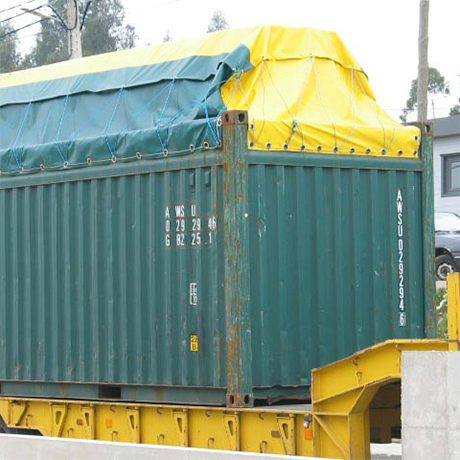

An open top container can transport higher vehicles than a standard container
The flat rack container (also known as lift-on / lift-off or lo-lo) has neither side walls nor a roof, but it has fixed or removable ends as well as anchorage points to attach the cargo. It’s loaded on top of other containers using a crane.
A flat rack is usually more expensive than a ro-ro and it’s not as secure as a container, as your vehicle is still accessible during transport. If the flat rack doesn’t fit into the hold because of its height and is then placed on the deck, your vehicle will be exposed to wind and salty water. It can be protected by wrapping it in a tarpaulin or plastic film used for pallets.
You’ll need to use a flat rack if your vehicle doesn’t fit into a closed container and if there’s no ro-ro on the shipping route you wish to take.
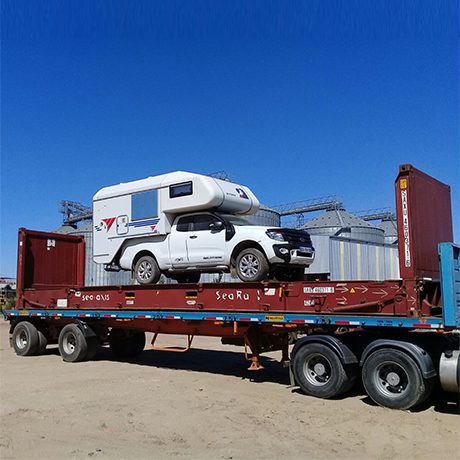

A truck camper on a flat rack
Break bulk cargo transports goods in individually packed units. Your vehicle is loaded directly into or onto the cargo ship, using dock cranes or those on the ship.
This type of transport is barely used by travellers any more, except in some small ports. It’s best to avoid this type of transport as much as possible.
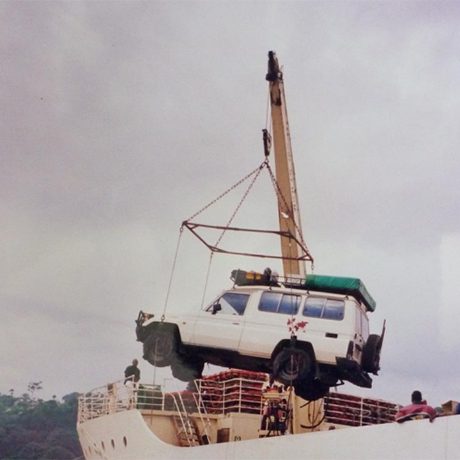

Let’s hope they don’t bash it…
When using maritime transport, several companies are involved:
Finding a shipping agent can take a lot of time. Large freight forwarders aren’t really interested in transporting a single vehicle. Therefore, they often don’t reply to your request or, if they do, it’s with an extortionate price. That’s why it’s important to limit your research to agents who’ve already been used by other overlanders. Request a quote for the shipment of your vehicle and settle on an agent who offers a competitive price, but who’s also accurate and responsive throughout your exchanges.
To help you find a freight forwarder / shipping agent, we’ve established a list of those who’ve already been used by other travellers.
Most UK overlanders use International Vehicle Shipping Services (IVSS). This English freight forwarder is the benchmark for English-speaking overlanders. They offer ro-ro and container transport. They cover a large number of destinations around the world and can operate between Panama and Cartagena in Colombia.
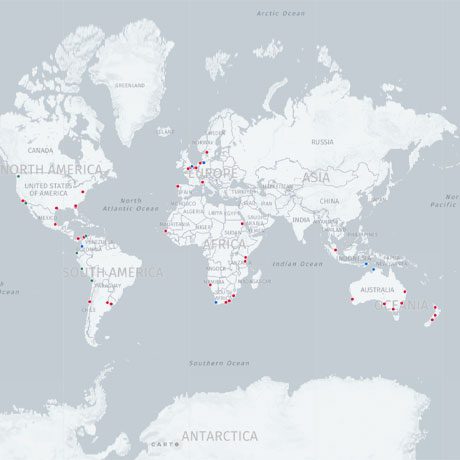

IVVS company port connections
Other freight forwarders / shipping agents used by travellers:
🇦🇺 Australia
Bell Total Logistics
🇧🇪 Belgium
Ziegler
Belgaco Shipping
🇨🇦 Canada
Protos Shipping
Atlantic Ex Works
Astra International
AmerXport
🇨🇴 Colombia
Enlace Caribe
🇫🇷 France
Long Cours
Bolloré Logistics
Groupe RTD
🇩🇪 Germany
Seabridge
🇮🇳 India
Seco Shipping
🇲🇾 Malaysia
Peninsular Freight
Vanguard Logistics
Korchina Logistics
Titan Logistics (Daryl)
🇴🇲 Oman
Sohar Shipping
Allied Logistics
🇵🇦 Panama
SeaBoard Marine
Ever Logistics
🇵🇪 Peru
Ian Taylor
🇸🇬 Singapore
Tandem Global Logistics
🇿🇦 South Africa
Econo Trans
African Overlanders
🇰🇷 South Korea
Sejin Global Logistics
🇨🇭 Switzerland
ITS Transport
🇹🇭 Thailand
Siam Shipping
🇺🇾 Uruguay
KMA
On the iOverlander app, zoom in on your departure port and in the filters, only check “Vehicle shipping”. You’ll find many agents with reviews from travellers who’ve used them.
In Facebook groups, ask other travellers which freight forwarders they used for the maritime route you want to cross.
Individuals can’t negotiate directly with shipping companies. You have to go through a freight forwarder / shipping agent. However, you can look for a company which does the desired journey and contact them to ask them for the list of agents they normally work with at the departure and arrival port (some put them on their website).
We’ve listed ro-ro companies with a link to maps of their maritime routes. Travellers mostly use Grimaldi, particularly for trips between the UK and America, via IVSS.


A Grimaldi ro-ro
On the busiest shipping routes (Southampton – Halifax for example), a big freight forwarder like IVSS charges you for a full service which includes marine insurance, arrival port charges, unloading, delivery and customs clearance. Therefore, they’ll be your only point of contact. You won’t need to contact a custom clearing agent at the port of arrival.
For quieter routes, you’ll need to get in touch with two intermediaries: a freight forwarder in the port of departure and a custom clearing agent in the port of arrival. Once you’ve found a freight forwarder in the port of departure, ask them which custom clearing agent they usually work with at the port of arrival and ask them for a quote.
The vocabulary can lead to confusion, as both “shipping agents” and “custom clearing agents” are often simply called “agents”.
Some travellers choose not to go through an intermediary in the port of arrival and instead handle the administrative procedures themselves to get their vehicle out. However, they’re few and far between, as the procedures are complex and the intermediaries are often difficult to find. What’s more, individuals aren’t always allowed to enter ports and documents sometimes have to be submitted through an IT system which isn’t always accessible to the public.
Travellers usually take a plane and wait for their vehicle to arrive whilst it’s transported by boat. However, on some journeys, particularly between the UK and America, you can board the same ship as your vehicle. It’s more expensive than a plane ($1,000 (£750) or $1,800 (£1300) per person according to the type of cabin for Antwerp (Belgium) to Halifax (Canada) with Seabridge for example).
If you think of this trip as a two-week “cruise”, it’s not that expensive: around $50 (£40) per day for full board. It’s an unforgettable experience and what’s more, you’ll be able to keep an eye on your vehicle during the stopovers.
You can find IVSS passenger fees for routes from Europe – South America here: Shipping Europe to South America RORO & Container.
You need to book your ticket way in advance, as ro-ros and container ships have very few cabins available for passengers.
For kids, the minimum age ranges from 3 to 16 years old depending on the company.


Travelling on a cargo ship is an unforgettable experience
Transporting a vehicle from one continent to another is expensive. It’s one of the biggest expense items for overlanders.
For many overlanders, a sea freight quote is so complex that it remains a mystery. To help you understand it better, we’ll give details of the most common items here.
The main item in your quote is freight: the shipping company’s cost to transport your vehicle. Freight is usually part of the freight forwarder’s invoice, but with small independant agents, sometimes it has to be paid to the shipping company directly.
In containers, there’s a rate for each type of container.
In ro-ros, the rate is usually calculated according to the number of cubic metres (CBM). For example, length 5.0 m x width 2.0 m x height 2.1 m = 21 CBM times the cost per CBM.
It can also sometimes be calculated like this:
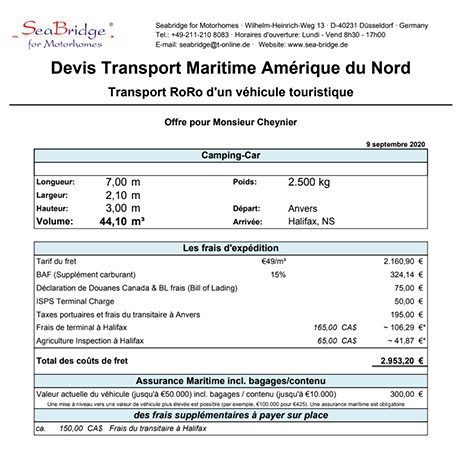

Quote from Seabridge to transport a motorhome between England and Halifax
In addition to the freight rate, you’ll need to pay additional costs which may be included in the freight forwarder’s quote or may have to be paid separately. Here are the most common (non-exhaustive list):
All of this may seem complicated, but in reality, you don’t need to understand each and every line of your quote. What matters to you is the total cost. Before signing, make sure your agents specify what’s included and what extra costs you’ll have to pay at ports to avoid any misunderstanding.
Maritime transport prices are always fluctuating dramatically. Here are the main factors influencing the cost of shipping:
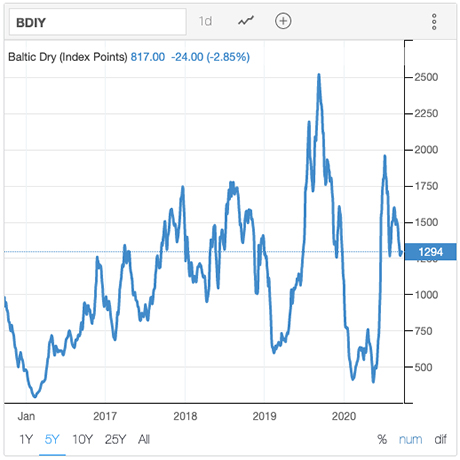

Evolution of the cost of sea freight worldwide
The average price doesn’t mean much, as each trip is different. But, to give you a vague idea, here’s the all-inclusive price for intercontinental sea transport for the following vehicles:
Here, we detail you the average all-inclusive shipping prices reported by our survey respondents. We’ve excluded motorbikes as the transport price is much less than those of other vehicles.
The most popular routes: Antwerp (Belgium) – Halifax (Canada) and Antwerp (Belgium) – Baltimore (United States), usually by ro-ro.
The most popular route: Antwerp (Belgium) – Montevideo (Uruguay).
The most popular route: Colón (Panama) – Cartagena (Colombia).
Vous pouvez réserver jusqu’à un an à l’avance, mais selon Seabridge, il est conseillé de réserver trois à quatre mois à l’avance. Il est généralement possible de réserver jusqu’à deux à trois semaines avant le départ. Pour les trajets entre l’Europe et l’Amérique, le printemps et début de l’été sont les plus périodes les plus demandées.
Pour réserver, vous devrez donner les informations détaillées de votre véhicule et envoyer les documents suivants :
Pour un transport en conteneur, dans certains pays on vous demandera aussi une liste exhaustive de tous les effets personnels qui se trouvent à l’intérieur du véhicule. La liste doit être suffisamment détaillée pour indiquer à l’inspecteur des douanes que vous n’avez rien à cacher.


Your freight forwarder will need copies of your vehicle registration document and your passport
From two months to five days before departure (it varies a lot), the port freight forwarder confirms the date on which your vehicle must be dropped off at the port of departure.
It’s quite common for them to subsequently announce a delay of one to two weeks. You’ll usually need to drop your vehicle off between ten and one day before the ship’s departure (again, this varies a lot).
The drop-off may take place inside or outside the port. If your vehicle is travelling in a container, a carrier may even come to put it in a container at your home.


Arrival at the port
To prevent your vehicle from being damaged during the manoeuvre, ask to get it into the container yourself. Unfortunately, this isn’t always allowed. Your vehicle will be securely attached with straps to prevent it from moving during transport.
Once your vehicle’s inside the container, you can close it and keep the keys. After their final inspection, the customs officers will close the container doors with a special seal. Your vehicle will therefore be safe during the crossing.
However, zero risk doesn’t exist. The container may be hit during handling or, even though it’s extremely rare, it may fall in the water during the crossing. These risks are covered by marine insurance.
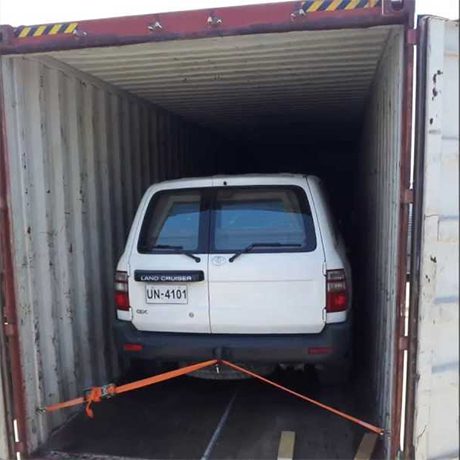

In the container, your vehicle is attached with straps
In a ro-ro, you won’t be able to put the vehicle on the boat yourself. You must leave the cabin open with the keys inside.
Even if you can close the cell door with a key, both our survey and our inquiries on Facebook overlander groups have highlighted that theft is, unfortunately, common.
On shipping routes between wealthy countries, like Liverpool – Halifax, there’s not much to worry about. But, if you depart or arrive in Latin American, Asian or African countries, the risk is higher.
Theft usually takes place at the port before or after the crossing. The vehicle is often completely empty, but even items of little value, like children’s textbooks, can go missing. Some travellers found their vehicle ransacked.
However, these precautions aren’t always enough to prevent theft. Therefore, some travellers try an alternative method. To prevent the vehicle from being damaged during breaking and entering, they deliberately leave the cell open with a few items inside.


Wire mesh partition between the cabin and the cell
Once your agent has picked up your vehicle, they take it through customs and have it loaded onto the ship. You can then follow the progress of the boat, live on the Marine Traffic website. The crossing can take several weeks on some routes.
When the departure date is set, ro-ros are usually fairly punctual. If your vehicle is travelling in a container, on the other hand, delays are more common due to itinerary changes, or even ship changes.
Unless you’re travelling on the same ship as your vehicle, you’ll arrive well ahead of it. Delays are common, especially in a container. Therefore, have a little patience whilst waiting for your vehicle to arrive.
Whilst waiting for its arrival at the port, get in touch with your agent. Confirm the documents you need to give them (bill of lading, vehicle registration document, passport, Carnet de Passages en Douane…) and make photocopies of them. Withdraw money so that you’ll be able to pay the fees.
Customs clearance often takes longer for containers than for ro-ros. If your vehicle’s container is right at the bottom of the pile, you’ll indeed have to wait for everything else to be handled before you can collect it.
Before leaving the port, carefully inspect your vehicle to check that nothing has been damaged or stolen. Once out, forget all about it and enjoy your trip!
This insurance isn’t compulsory, but highly recommended. It costs around 0.9% of the vehicle’s value. It will often be included in your freight forwarder’s quote.
Generally speaking, marine insurance covers the total loss of the vehicle (particularly if the boat sinks), but not theft during shipping. If your vehicle is damaged during transport, vehicle damage will only be refunded if the cost of repairs exceed the excess. Scratches and other minor damage aren’t covered.
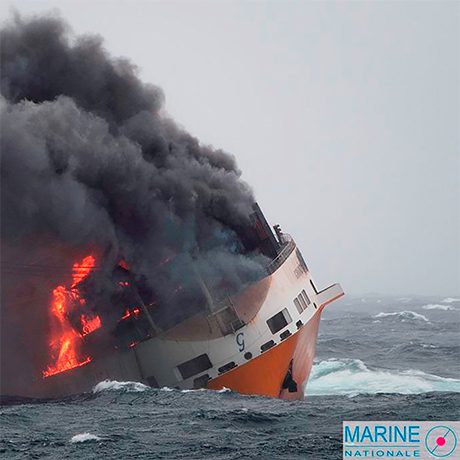

This Grand America ro-ro sunk in 2019 with many travellers’ vehicles on board
According to ADEME’s Carbon Database (Agency for Ecological Transition), maritime transport generates 0.00847 kg of CO2 per tonne and per kilometre in containers and 0.0457 kg of CO2 per tonne and per kilometre in ro-ros.
For the same weight, transporting a vehicle in a ro-ro would therefore be five times more polluting than in a container. We don’t know why the gap is so large, but we can assume that container ships carry much more merchandise than ro-ros and therefore their CO2 emissions per tonne are lower.
A round trip from the UK to America (Liverpool – Halifax then Montevideo – Liverpool) with a Volkswagen California T4 campervan weighing 1.8 tonnes in a container emits 0.3 tonnes of CO2.
A round trip from the UK to America (Liverpool – Halifax then Montevideo – Liverpool) with a Ford Challenger motorhome weighing 3 tonnes in a ro-ro emits 2.2 tonnes of CO2.
The same trip by plane emits 3.8 tonnes of CO2 per passenger. Therefore, your flights contribute more to global warming than the transport of your vehicle.
The most efficient way to limit your CO2 emissions is to avoid taking a plane.
If you board as a passenger on the same ship as your vehicle, your CO2 emissions can be seen as limited to those of the transport of your vehicle. After all, even if none of the passenger cabins of a ship are filled, it’ll still leave. Whereas, if none of the seats on a plane are sold, it won’t leave.
To avoid emissions related to the transport of your vehicle, you can choose to buy it out there, in the US, Canada or Chile for example.
If you really want to travel and have “net zero carbon emissions”, you can cross oceans by boat-hitchhiking and get around out there on bike or by hitchhiking.

